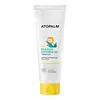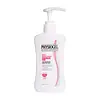What's inside
What's inside
 Key Ingredients
Key Ingredients

 Benefits
Benefits

 Ingredients Side-by-side
Ingredients Side-by-side

Aloe Barbadensis Leaf Juice
Skin Conditioning1,2-Hexanediol
Skin ConditioningPentylene Glycol
Skin ConditioningCentella Asiatica Extract
CleansingCarbomer
Emulsion StabilisingArginine
MaskingHydroxypropyl Methylcellulose
Emulsion StabilisingAllantoin
Skin ConditioningCaprylyl Glycol
EmollientWater
Skin ConditioningEthylhexylglycerin
Skin ConditioningDisodium EDTA
Glycerin
HumectantHydrolyzed Hyaluronic Acid
HumectantMentha Suaveolens Leaf Extract
AstringentMadecassoside
AntioxidantMyristoyl/Palmitoyl Oxostearamide/Arachamide Mea
Skin ConditioningButylene Glycol
HumectantPropanediol
SolventAsiaticoside
AntioxidantMadecassic Acid
Skin ConditioningAsiatic Acid
Skin ConditioningSorghum Bicolor Leaf/Stem Extract
Skin ConditioningAspergillus Ferment
Skin ConditioningBrassica Oleracea Italica Extract
AstringentMedicago Sativa Extract
TonicBrassica Oleracea Capitata Leaf Extract
Skin ConditioningTriticum Vulgare Sprout Extract
Skin ConditioningBrassica Campestris Extract
Skin ConditioningRaphanus Sativus Seed Extract
Skin ConditioningSaccharide Isomerate
HumectantAloe Barbadensis Leaf Juice, 1,2-Hexanediol, Pentylene Glycol, Centella Asiatica Extract, Carbomer, Arginine, Hydroxypropyl Methylcellulose, Allantoin, Caprylyl Glycol, Water, Ethylhexylglycerin, Disodium EDTA, Glycerin, Hydrolyzed Hyaluronic Acid, Mentha Suaveolens Leaf Extract, Madecassoside, Myristoyl/Palmitoyl Oxostearamide/Arachamide Mea, Butylene Glycol, Propanediol, Asiaticoside, Madecassic Acid, Asiatic Acid, Sorghum Bicolor Leaf/Stem Extract, Aspergillus Ferment, Brassica Oleracea Italica Extract, Medicago Sativa Extract, Brassica Oleracea Capitata Leaf Extract, Triticum Vulgare Sprout Extract, Brassica Campestris Extract, Raphanus Sativus Seed Extract, Saccharide Isomerate
Water
Skin ConditioningPentylene Glycol
Skin ConditioningPolyglyceryl-4 Caprate
EmulsifyingGlycerin
HumectantAloe Barbadensis Leaf Extract
EmollientAllantoin
Skin ConditioningPanthenol
Skin ConditioningInulin
Skin ConditioningMaltodextrin
AbsorbentBeta-Glucan
Skin ConditioningYeast Extract
Skin ConditioningSaccharomyces Cerevisiae Extract
Skin ConditioningBifida Ferment Lysate
Skin ConditioningLactobacillus Ferment Lysate
Skin ConditioningSodium Hyaluronate
HumectantSqualane
EmollientCeramide NP
Skin ConditioningHydrogenated Lecithin
EmulsifyingCaprylic/Capric Triglyceride
MaskingSarcosine
Skin ConditioningPalmitamide Mea
Acetamide Mea
HumectantRosmarinus Officinalis Leaf Oil
MaskingJuniperus Mexicana Oil
MaskingCarbomer
Emulsion StabilisingTromethamine
Buffering1,2-Hexanediol
Skin ConditioningCaprylyl Glycol
EmollientTrisodium EDTA
Butylene Glycol
HumectantEthylhexylglycerin
Skin ConditioningWater, Pentylene Glycol, Polyglyceryl-4 Caprate, Glycerin, Aloe Barbadensis Leaf Extract, Allantoin, Panthenol, Inulin, Maltodextrin, Beta-Glucan, Yeast Extract, Saccharomyces Cerevisiae Extract, Bifida Ferment Lysate, Lactobacillus Ferment Lysate, Sodium Hyaluronate, Squalane, Ceramide NP, Hydrogenated Lecithin, Caprylic/Capric Triglyceride, Sarcosine, Palmitamide Mea, Acetamide Mea, Rosmarinus Officinalis Leaf Oil, Juniperus Mexicana Oil, Carbomer, Tromethamine, 1,2-Hexanediol, Caprylyl Glycol, Trisodium EDTA, Butylene Glycol, Ethylhexylglycerin
Ingredients Explained
These ingredients are found in both products.
Ingredients higher up in an ingredient list are typically present in a larger amount.
1,2-Hexanediol is a synthetic liquid and another multi-functional powerhouse.
It is a:
- Humectant, drawing moisture into the skin
- Emollient, helping to soften skin
- Solvent, dispersing and stabilizing formulas
- Preservative booster, enhancing the antimicrobial activity of other preservatives
Allantoin is a soothing ingredient known for its protective and moisturizingg properties. Because of this, it is often added to products with strong active ingredients.
Studies show higher concentrations of this ingredient can promote wound healing.
Though it can be derived from the comfrey plant, allantoin is produced synthetically for cosmetic products to ensure purity.
Learn more about AllantoinButylene Glycol (or BG) is used within cosmetic products for a few different reasons:
Overall, Butylene Glycol is a safe and well-rounded ingredient that works well with other ingredients.
Though this ingredient works well with most skin types, some people with sensitive skin may experience a reaction such as allergic rashes, closed comedones, or itchiness.
Learn more about Butylene GlycolCaprylyl Glycol is a humectant and emollient, meaning it attracts and preserves moisture.
It is a common ingredient in many products, especially those designed to hydrate skin. The primary benefits are retaining moisture, skin softening, and promoting a healthy skin barrier.
Though Caprylyl Glycol is an alcohol derived from fatty acids, it is not the kind that can dry out skin.
This ingredient is also used as a preservative to extend the life of products. It has slight antimicrobial properties.
Learn more about Caprylyl GlycolCarbomer is a polymer of acrylic acid. Its main role is to create a gel consistency.
A high amount of carbomer can cause pilling or balling up of products. Don't worry, most products contain 1% or less of carbomer.
Ethylhexylglycerin (we can't pronounce this either) is commonly used as a preservative and skin softener. It is derived from glyceryl.
You might see Ethylhexylglycerin often paired with other preservatives such as phenoxyethanol. Ethylhexylglycerin has been found to increase the effectiveness of these other preservatives.
Glycerin is already naturally found in your skin. It helps moisturize and protect your skin.
A study from 2016 found glycerin to be more effective as a humectant than AHAs and hyaluronic acid.
As a humectant, it helps the skin stay hydrated by pulling moisture to your skin. The low molecular weight of glycerin allows it to pull moisture into the deeper layers of your skin.
Hydrated skin improves your skin barrier; Your skin barrier helps protect against irritants and bacteria.
Glycerin has also been found to have antimicrobial and antiviral properties. Due to these properties, glycerin is often used in wound and burn treatments.
In cosmetics, glycerin is usually derived from plants such as soybean or palm. However, it can also be sourced from animals, such as tallow or animal fat.
This ingredient is organic, colorless, odorless, and non-toxic.
Glycerin is the name for this ingredient in American English. British English uses Glycerol/Glycerine.
Learn more about GlycerinPentylene glycol is typically used within a product to thicken it. It also adds a smooth, soft, and moisturizing feel to the product. It is naturally found in plants such as sugar beets.
The hydrophilic trait of Pentylene Glycol makes it a humectant. As a humectant, Pentylene Glycol helps draw moisture from the air to your skin. This can help keep your skin hydrated.
This property also makes Pentylene Glycol a great texture enhancer. It can also help thicken or stabilize a product.
Pentylene Glycol also acts as a mild preservative and helps to keep a product microbe-free.
Some people may experience mild eye and skin irritation from Pentylene Glycol. We always recommend speaking with a professional about using this ingredient in your routine.
Pentylene Glycol has a low molecular weight and is part of the 1,2-glycol family.
Learn more about Pentylene GlycolWater. It's the most common cosmetic ingredient of all. You'll usually see it at the top of ingredient lists, meaning that it makes up the largest part of the product.
So why is it so popular? Water most often acts as a solvent - this means that it helps dissolve other ingredients into the formulation.
You'll also recognize water as that liquid we all need to stay alive. If you see this, drink a glass of water. Stay hydrated!
Learn more about Water